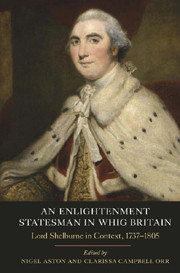Book contents
- Frontmatter
- Contents
- List of Illustrations
- List of Contributors
- Acknowledgements
- List of Abbreviations
- Introduction
- Part One Family, Piety, and Finance
- Part Two Politics
- Part Three The Bowood Circle Revisited
- 9 ‘Opening the Door to Truth and Liberty’: Bowood's French Connection
- 10 Lord Shelburne's Constitutional Views in 1782–3
- 11 Jeremy Bentham at Bowood
- 12 Shelburne and Perpetual Peace: Small States, Commerce, and International Relations within the Bowood Circle
- Index
- STUDIES IN EARLY MODERN CULTURAL, POLITICAL AND SOCIAL HISTORY
11 - Jeremy Bentham at Bowood
from Part Three - The Bowood Circle Revisited
Published online by Cambridge University Press: 05 September 2013
- Frontmatter
- Contents
- List of Illustrations
- List of Contributors
- Acknowledgements
- List of Abbreviations
- Introduction
- Part One Family, Piety, and Finance
- Part Two Politics
- Part Three The Bowood Circle Revisited
- 9 ‘Opening the Door to Truth and Liberty’: Bowood's French Connection
- 10 Lord Shelburne's Constitutional Views in 1782–3
- 11 Jeremy Bentham at Bowood
- 12 Shelburne and Perpetual Peace: Small States, Commerce, and International Relations within the Bowood Circle
- Index
- STUDIES IN EARLY MODERN CULTURAL, POLITICAL AND SOCIAL HISTORY
Summary
Lord Shelburne (after 1785, Lord Lansdowne) has often been presented as Bentham's ‘mentor’, or ‘patron’, while Derek Jarrett, with a note of irony, called the utilitarian philosopher ‘another of [Lord Shelburne's] tame intellectuals’. In the later part of his life, Bentham was keen to repeat a flattering comparison Shelburne had made between their relationship and that of Bacon and Buckingham. These comparisons and simplifications do not do justice, however, to the relationship between Jeremy Bentham and Lord Shelburne.
By focusing on the links between Bentham and Shelburne, this chapter will clarify the meaning of the phrase ‘the Bowood Circle’, when used in connection with Bentham. As first used by Charles Milner Atkinson in 1905, it referred in a generic way to the people Bentham had met during his stays at Bowood, Shelburne's Wiltshire residence in the 1780s. It was taken up by Jarrett in his 1955 thesis entitled ‘The Bowood Circle, 1780–1793. Its Ideas and its Influence’. Jarrett narrowed down the definition of that circle to Bentham, Etienne Dumont and Samuel Romilly, who were all close to Lord Lansdowne in the years 1788 to 1793. More recently, the phrase has been used by scholars to refer in a broader sense to Shelburne's entourage at the time of the French Revolution, ranging from Price and Priestley to Fox and Sheridan, and also including Dumont and Romilly. Leaving politicians and aristocrats such as Fox and Sheridan aside, this chapter focuses on the relationships between Lansdowne and some of his protégés during the 1780s in order to put Bentham's relationship with the aristocrat in context.
- Type
- Chapter
- Information
- An Enlightenment Statesman in Whig BritainLord Shelburne in Context, 1737–1805, pp. 233 - 248Publisher: Boydell & BrewerPrint publication year: 2011



